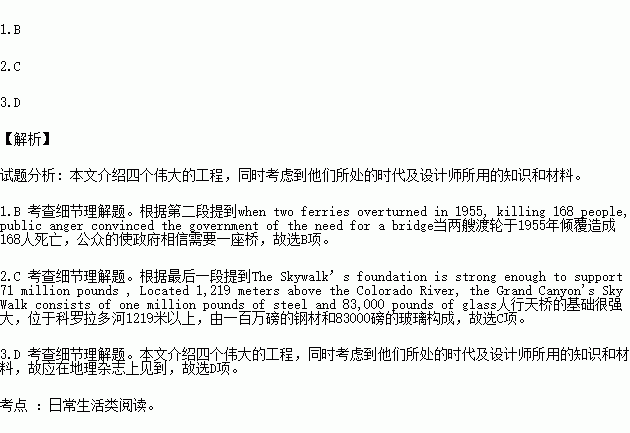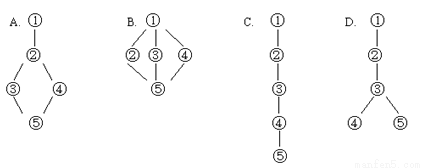题目内容
Taj Mahal, Agra, India
As many as 28 different varieties of precious stones were used to decorate the outside of the Taj Mahal. Construction took around 20 years. The building, which was made from white marble from the quarries(采石场) of Rajasthan, appears pink in the morning, white in the day and golden in the moonlight.
Akashi Kaikyo Bridge, Akashi Strait, Japan
It took 10 years to construct the Akashi Kaikyo Bridge. It connects the city of Kobe, on Japan’s mainland, with Iwaya on Awaji Island. Before it opened, the only way to get between the two cities was by ferry. However, the waterway was at the mercy of severe storms and when two ferries overturned in 1955, killing 168 people, public anger convinced the government of the need for a bridge. It's the longest suspension bridge in the world, with a length of 1,991 meters.
Panama Canal, Panama
More than 4. 5 million cubic yards of concrete were used in the construction of this canal’s locks and dams. The Panama Canal is a 47-mile long waterway that connects the Atlantic and Pacific Oceans. The earth and rubble dug to make way for it was enough to bury Manhattan to a depth of four meters. A series of locks allows ships to pass through the water. Each lock door weighs 750 tons and each lock fills with 52 million gallons of water to accommodate the 15,000 ships that use the canal every year.
Grand Canyon Skywalk, Arizona
The Skywalk’s foundation is strong enough to support 71 million pounds , Located 1,219 meters above the Colorado River, the Grand Canyon's Sky Walk consists of one million pounds of steel and 83,000 pounds of glass. It was the creation of Las Vegas businessman David Jin, who approached the Hualapai Tribe with the idea of a glass walkway over the Grand Canyon in 1996. The Sky walk was assembled on site.
1.The Japanese government decided to build the Akashi Kaikyo Bridge ___________
A. in the year of 1955
B. following public opinion
C. to show its national power
D. to develop Japan’s economy
2.The Grand Canyon Skywalk is probably a real challenge for those who __________
A. are airsick
B. hate rock climbing
C. have a fear of height
D. feel ill traveling in boat
3.In which section of a book can the text probably be seen?
A. Science B. Agriculture C. Technology D. Geography


